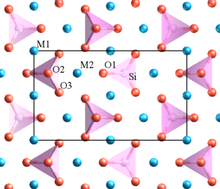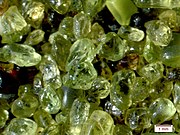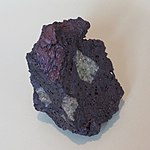Olivine
| Olivine | |
|---|---|
| Optical properties | Biaxial (+) |
| Refractive index | nα = 1.630–1.650 nβ = 1.650–1.670 nγ = 1.670–1.690 |
| Birefringence | δ = 0.040 |
| References | [6][7][8] |
The

The ratio of magnesium to iron varies between the two
2SiO
4) and fayalite (Fe-endmember: Fe
2SiO
4). Compositions of olivine are commonly expressed as molar percentages of forsterite (Fo) and/or fayalite (Fa) (e.g., Fo70Fa30, or just Fo70 with Fa30 implied). Forsterite's melting temperature is unusually high at atmospheric pressure, almost 1,900 °C (3,450 °F), while fayalite's is much lower – about 1,200 °C (2,190 °F). Melting temperature varies smoothly between the two endmembers, as do other properties. Olivine incorporates only minor amounts of elements other than oxygen (O), silicon (Si), magnesium (Mg) and iron (Fe). Manganese (Mn) and nickel
Olivine gives its name to the group of minerals with a related structure (the olivine group) – which includes
Olivine's crystal structure incorporates aspects of the
Identification and paragenesis
Olivine is named for its typically olive-green color, thought to be a result of traces of nickel,[citation needed] though it may alter to a reddish color from the oxidation of iron.
Translucent olivine is sometimes used as a gemstone called peridot (péridot, the French word for olivine). It is also called chrysolite (or chrysolithe, from the Greek words for gold and stone), though this name is now rarely used in the English language. Some of the finest gem-quality olivine has been obtained from a body of mantle rocks on Zabargad Island in the Red Sea.[12][13]
Olivine occurs in both
Fe-rich olivine
Mg-rich olivine is stable to pressures equivalent to a depth of about 410 km (250 mi) within Earth. Because it is thought to be the most abundant mineral in Earth's mantle at shallower depths, the properties of olivine have a dominant influence upon the
Olivine pine forest (a plant community) is unique to Norway. It is rare and found on dry olivine ridges in the fjord districts of Sunnmøre and Nordfjord.[18]
-
Light green olivine crystals in peridotite xenoliths in basalt from Arizona
-
Bright green olivine from Pakistan, showing chisel termination and silky luster
-
Olivine in lava from the Azores
Extraterrestrial occurrences

Mg-rich olivine has also been discovered in meteorites,[19] on the Moon[20] and Mars,[21][22] falling into infant stars,[23] as well as on asteroid 25143 Itokawa.[24] Such meteorites include chondrites, collections of debris from the early Solar System; and pallasites, mixes of iron-nickel and olivine. The rare A-type asteroids are suspected to have a surface dominated by olivine.[25]
The spectral signature of olivine has been seen in the dust disks around young stars. The tails of comets (which formed from the dust disk around the young Sun) often have the spectral signature of olivine, and the presence of olivine was verified in samples of a comet from the Stardust spacecraft in 2006.[26] Comet-like (magnesium-rich) olivine has also been detected in the planetesimal belt around the star Beta Pictoris.[27]
Crystal structure

Minerals in the olivine group crystallize in the
There are three distinct oxygen sites (marked O1, O2 and O3 in figure 1), two distinct metal sites (M1 and M2) and only one distinct silicon site. O1, O2, M2 and Si all lie on
High-pressure polymorphs
At the high temperatures and pressures found at depth within the Earth the olivine structure is no longer stable. Below depths of about 410 km (250 mi) olivine undergoes an exothermic
The pressure at which these phase transitions occur depends on temperature and iron content.
2SiO
4 spinel at pressures below 5 GPa (49,000 atm). Increasing the temperature increases the pressure of these phase transitions.
Weathering

Olivine is one of the less stable common minerals on the surface according to the Goldich dissolution series. It alters into iddingsite (a combination of clay minerals, iron oxides and ferrihydrite) readily in the presence of water.[30] Artificially increasing the weathering rate of olivine, e.g. by dispersing fine-grained olivine on beaches, has been proposed as a cheap way to sequester CO2.[31][32] The presence of iddingsite on Mars would suggest that liquid water once existed there, and might enable scientists to determine when there was last liquid water on the planet.[33]
Because of its rapid weathering, olivine is rarely found in sedimentary rock.[34]
Mining
Norway

Norway is the main source of olivine in Europe, particularly in an area stretching from Åheim to Tafjord, and from Hornindal to Flemsøy in the Sunnmøre district. There is also olivine in Eid municipality. About 50% of the world's olivine for industrial use is produced in Norway. At Svarthammaren in Norddal olivine was mined from around 1920 to 1979, with a daily output up to 600 metric tons. Olivine was also obtained from the construction site of the hydro power stations in Tafjord. At Robbervika in Norddal municipality an open-pit mine has been in operation since 1984. The characteristic red color is reflected in several local names with "red" such as Raudbergvik (Red rock bay) or Raudnakken (Red ridge).[35][36][37][38]
Hans Strøm in 1766 described the olivine's typical red color on the surface and the blue color within. Strøm wrote that in Norddal district large quantities of olivine were broken from the bedrock and used as sharpening stones.[39]
Kallskaret near Tafjord is a nature reserve with olivine.[40]
Uses
A worldwide search is on for cheap processes to sequester CO2 by mineral reactions, called enhanced weathering. Removal by reactions with olivine is an attractive option, because it is widely available and reacts easily with the (acid) CO2 from the atmosphere. When olivine is crushed, it weathers completely within a few years, depending on the grain size. All the CO2 that is produced by burning one liter of oil can be sequestered by less than one liter of olivine. The reaction is exothermic but slow. To recover the heat produced by the reaction to produce electricity, a large volume of olivine must be thermally well-isolated. The end-products of the reaction are silicon dioxide, magnesium carbonate, and small amounts of iron oxide.[41][42] A nonprofit, Project Vesta, is investigating this approach on beaches which increase the agitation and surface area of crushed olivine through wave action.[43]
Olivine is used as a substitute for dolomite in steel works.[44]
The aluminium foundry industry uses olivine sand to cast objects in aluminium. Olivine sand requires less water than silica sands while still holding the mold together during handling and pouring of the metal. Less water means less gas (steam) to vent from the mold as metal is poured into the mold.[45]
In Finland, olivine is marketed as an ideal rock for sauna stoves because of its comparatively high density and resistance to weathering under repeated heating and cooling.[46]
Gem-quality olivine is used as a gemstone called peridot.
See also
- Bowen's reaction series – Order of crystallization of minerals in magma
- List of minerals – List of minerals with Wikipedia articles
References
- S2CID 235729616.
- ISBN 978-1-86239-029-4.
Specific Gravity 3.5–4.5
- ISBN 978-0-87335-233-8.
The specific gravity is approximately 3.2 when pure rises with increasing iron content.
- ^ "Olivine". Science.smith.edu. Archived from the original on 2014-01-20. Retrieved 2013-11-14.
G = 3.22 to 4.39. Specific gravity increases and hardness decreases with increasing Fe.
- ^ "University of Minnesota's Mineral Pages: Olivine". Geo.umn.edu. Archived from the original on 2013-10-17. Retrieved 2013-11-14.
Specific Gravity: 3.2 (Mg-rich variety) to 4.3 (Iron-rich variety) (average weight)
- ^ Olivine Archived 2014-12-09 at the Wayback Machine. Webmineral.com Retrieved on 2012-06-16.
- ^ Olivine Archived 2008-02-02 at the Wayback Machine. Mindat.org Retrieved on 2012-06-16.
- ISBN 978-0-471-80580-9.
- ISBN 9781426212826.
- ^ Klein & Hurlbut 1985, p. 373.
- ^ Ernst, W. G. Earth Materials. Englewood Cliffs, NJ: Prentice-Hall, 1969. p. 65
- ^ St. John's Island peridot information and history at Mindat.org
- . Retrieved 6 February 2021.
- ^ Klein & Hurlbut 1985, pp. 374–375.
- ISBN 9780521880060.
- ^ McDonough, W.F.; Rudnick, R.L. (1998). "Mineralogy and composition of the upper mantle". Reviews in Mineralogy. 37: 139–164. Retrieved 6 February 2021.
- S2CID 35342757. Archived from the original(PDF) on 2017-08-09. Retrieved 2017-10-26.
- ^ Brandrud, T.E. (2009). "Olivinfuruskog og rødlistearter i Bjørkedalen, Volda: naturverdi og forvaltningsmuligheter". NINA Rapport (in Norwegian). 461. Retrieved 14 February 2021.
- ^ Fukang and other Pallasites Archived 2008-12-21 at the Wayback Machine. Farlang.com (2008-04-30). Retrieved on 2012-06-16.
- ^ Meyer, C. (2003). "Mare Basalt Volcanism" (PDF). NASA Lunar Petrographic Educational Thin Section Set. NASA. Archived (PDF) from the original on 21 December 2016. Retrieved 23 October 2016.
- ^ Pretty Green Mineral.... Archived 2007-05-04 at the Wayback MachineMission Update 2006... Archived 2010-06-05 at the Wayback Machine UMD Deep Impact Website, University of Maryland Ball Aerospace & Technology Corp. retrieved June 1, 2010
- S2CID 20122017."
- ^ Spitzer Sees Crystal Rain... Archived 2011-05-29 at the Wayback Machine NASA Website
- ^ Japan says Hayabusa brought back asteroid grains... Archived 2010-11-18 at the Wayback Machine retrieved November 18, 2010
- S2CID 42791787.
- ^ Press Release 06-091 Archived 2006-08-28 at the Wayback Machine. Jet Propulsion Laboratory Stardust website, retrieved May 30, 2006.
- S2CID 205230613.
- .
- ISBN 978-0-582-30094-1.
- Bibcode:2003LPI....34.1953K. Archived(PDF) from the original on 2012-10-25.
- ^ Goldberg, Philip; Chen Zhong-Yin; Connor, William'O; Walters, Richards; Ziock, Hans (2001). "CO2 Mineral Sequestration Studies in US" (PDF). Archived from the original (PDF) on 2016-12-21. Retrieved 2016-12-19.
- ^ Schuiling, R.D.; Tickell, O. "Olivine against climate change and ocean acidification" (PDF). Archived from the original (PDF) on 2016-09-27. Retrieved 2016-12-19.
- .
- .
- ^ Furseth, Astor (1987): Norddal i 150 år. Valldal: Norddal kommune.
- ^ Geological Survey of Norway. Kart over mineralressurser Archived 2017-10-14 at the Wayback Machine. Accessed 9.12.2012.
- ^ "Olivin". www.ngu.no (in Norwegian Bokmål). Archived from the original on 2017-11-10. Retrieved 2017-11-09.
- ^ Gjelsvik, T. (1951). Oversikt over bergartene i Sunnmøre og tilgrensende deler av Nordfjord Archived 2017-11-10 at the Wayback Machine. Norge geologiske undersøkelser, report 179.
- ^ Strøm, Hans: Physisk og Oeconomisk Beskrivelse over Fogderiet Søndmør beliggende i Bergen Stift i Norge. Published in Sorø, Denmark, 1766.
- ^ "Kallskaret". 28 September 2014. Archived from the original on 10 November 2017. Retrieved 3 May 2018 – via Store norske leksikon.
- ^ Goldberg, P.; Chen, Z.-Y.; O'Connor, W.; Walters, R.; Ziock, H. (2000). "CO2 Mineral Sequestration Studies in US" (PDF). Technology. 1 (1): 1–10. Archived from the original (PDF) on 2003-12-07. Retrieved 2008-07-07.
- S2CID 131280491.
- ^ Delbert, Caroline (2020-06-11). "How This Strange Green Sand Could Reverse Climate Change". Popular Mechanics. Retrieved 2020-11-06.
- ^ Mineralressurser i Norge ; Mineralstatistikk og bergverksberetning 2006. Trondheim: Bergvesenet med bergmesteren for Svalbard. 2007.
- ISBN 978-0-8306-9970-4.
- ^ "The olivine stone". Suomen Kiuaskivi. Archived from the original on 5 March 2021. Retrieved 14 February 2021.
External links
- Pretty Green Mineral – Pretty Dry Mars? by Linda M.V. Martel, Planetary Science Research Discoveries, Hawai'i Institute of Geophysics and Planetology
- Olivine Page Farlang library: Historic sources + modern articles on Olivine and Peridot
- Geological information and several microscopic images University of North Dakota






